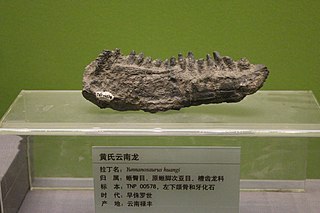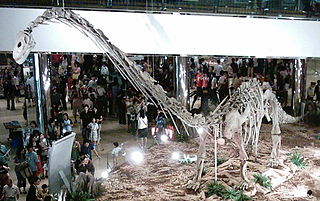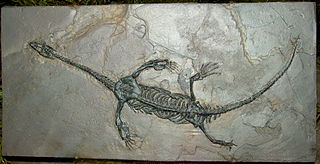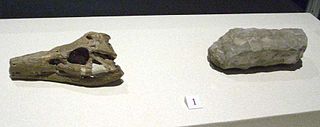
Mussaurus is a genus of herbivorous sauropodomorph dinosaur that lived in southern Argentina during the Sinemurian stage of the Early Jurassic. It receives its name from the small size of the skeletons of juvenile and infant individuals, which were once the only known specimens of the genus. However, since Mussaurus is now known from adult specimens, the name is something of a misnomer.

Massospondylus was a genus of sauropodomorph dinosaur from the Early Jurassic. It was described by Sir Richard Owen in 1854 from remains discovered in South Africa, and is thus one of the first dinosaurs to have been named. Fossils have since been found at other locations in South Africa, Lesotho, and Zimbabwe. Material from Arizona's Kayenta Formation, India, and Argentina has been assigned to the genus at various times, but the Arizonan and Argentinian material are now assigned to other genera.

Crichtonsaurus is a genus of herbivorous ankylosaurid dinosaur that lived during the Late Cretaceous in what is now China. It was named after Michael Crichton, the author of the dinosaur novel Jurassic Park. A sister taxon was discovered, C. benxiensis, which is now identified as a separate genus.

Lufengosaurus is a genus of massospondylid dinosaur which lived during the Early Jurassic period in what is now southwestern China.
Yimenosaurus is an extinct genus of plateosaurid sauropodomorph dinosaur that lived in China in the Early Jurassic. The genus was first named in 1990 by Ziqi Bai, Jie Yang and Guohui Wang, along with its type and only species, Yimenosaurus youngi. The species name honours renowned Chinese paleontologist Yang Zhongjian, the father of Chinese paleontology, known as C.C. Young in English. Known material includes the holotype, an almost complete skull and mandible, as well as incomplete cervical and dorsal vertebrae, a mostly complete sacrum, an ilium, ischia, partial ribs and complete femur, and a paratype, a well-preserved postcrania with a fragmentary skull. In 2010 Paul estimated its length at 9 metres (30 ft) and its weight at 2 tonnes.

Yunnanosaurus is an extinct genus of sauropodomorph dinosaur that lived approximately 199 to 183 million years ago in what is now the Yunnan Province, in China, for which it was named. Yunnanosaurus was a large sized, moderately-built, ground-dwelling, quadrupedal herbivore, that could also walk bipedally, and ranged in size from 7 meters (23 feet) long and 2 m (6.5 ft) high to 4 m (13 ft) high in the largest species.

Omeisaurus is a genus of sauropod dinosaur from the Middle Jurassic Period of what is now China. Its name comes from Mount Emei, where it was discovered in the lower Shaximiao Formation of Sichuan Province.

Zupaysaurus is an extinct genus of early theropod dinosaur living during the Norian stage of the Late Triassic in what is now Argentina. Fossils of the dinosaur were found in the Los Colorados Formation of the Ischigualasto-Villa Unión Basin in northwestern Argentina. Although a full skeleton has not yet been discovered, Zupaysaurus can be considered a bipedal predator, up to 4 metres (13 ft) long. It may have had two parallel crests running the length of its snout.

Sinovenator is a genus of troodontid dinosaur from China. It is from the early Cretaceous Period.
Gongxianosaurus is a genus of basal sauropod dinosaur from the early Jurassic Period. The only species is Gongxianosaurus shibeiensis. Based on four fragmentary to complete specimens found in China, it is one of the most completely known early sauropods. The skeleton is known in large part, missing both the hand and the majority of the skull. Gongxianosaurus was firstly named and described in a short note published in 1998; however, a comprehensive description has yet to be published. Gongxianosaurus shibeiensis was named for the place it was found, near the village Shibei in Gong County.

Patagosaurus is an extinct genus of eusauropod dinosaur from the Middle-Late Toarcian of Patagonia, Argentina. It was first found in deposits of the Cañadón Asfalto Formation, which date to around 179 to 177 million years ago. Although originally twelve specimens were assigned to the taxon, at least one of them may belong to a different genus. Patagosaurus probably lived alongside genera as Piatnitzkysaurus, Condorraptor and Volkheimeria.
The Ziliujing Formation is a geological formation in China, It is Early Jurassic in age. It is part of the stratigraphy of the Sichuan Basin. The dinosaur Gongxianosaurus and indeterminate theropod material are known from the Dongyuemiao Member of the formation, as well as dinosaur footprints, Zizhongosaurus and indeterminate prosauropods from the Da'anzhai Member. The basal sauropod Sanpasaurus is known from the Maanshan Member. An unnamed stegosaur and the pliosauroid plesiosaur Sinopliosaurus are also known from this formation but they were found an indeterminate member. An unnamed teleosaurid known from a complete skull has also been found in the formation, pending a formal description. The deposition environment during the Da'anzhai Member in the lower Toarcian is thought to have been that of a giant freshwater lake encompassing the whole of the Sichuan basin, around 3 times larger than Lake Superior, coeval with the Toarcian Oceanic Anoxic Event around 183 Ma.

Keichousaurus is an extinct genus of pachypleurosaurian marine reptile from the Chialingchiang and Falang Formations of China with two known species attributed to the genus: K. hui and K. yuananensis.

Hsisosuchus is an extinct genus of crocodyliform from China. Currently there are three species within this genus: H. dashanpuensis is from the Middle Jurassic, while H. chungkingensis and H. chowi are from the Late Jurassic. It is likely to have been a medium-sized predator.

Sarahsaurus is a genus of basal sauropodomorph dinosaur which lived during the Early Jurassic period in what is now northeastern Arizona, United States.

Leyesaurus is an extinct genus of massospondylid sauropodomorph dinosaur known from the San Juan Province, northwestern Argentina.
Qijianglong is a genus of herbivorous mamenchisaurid sauropod dinosaur from the Early Cretaceous of China.
Crichtonpelta is a genus of extinct herbivorous ankylosaurid dinosaur from the Late Cretaceous (Cenomanian) of China.

Lingwulong is a genus of dicraeosaurid sauropod dinosaur from the Middle Jurassic of what is now Lingwu, Yinchuan, Ningxia, China. The type and only species is L. shenqi, known from several partial skeletons. It is the earliest-aged neosauropod ever discovered, as well as the only definite diplodocoid from east Asia.
This article records new taxa of fossil archosaurs of every kind that are scheduled described during the year 2022, as well as other significant discoveries and events related to paleontology of archosaurs that are scheduled to occur in the year 2022.





























